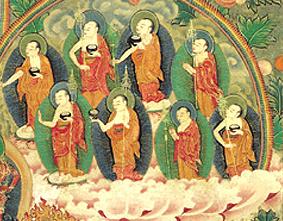Shravaka: Difference between revisions
Jump to navigation
Jump to search
mNo edit summary |
No edit summary |
||
| (3 intermediate revisions by 2 users not shown) | |||
| Line 1: | Line 1: | ||
[[Image:Shravakas.JPG|frame|Shravaka disciples from the [[Longchen Nyingtik]] [[field of merit|Field of Merit]]]] | [[Image:Shravakas.JPG|frame|Shravaka disciples from the [[Longchen Nyingtik]] [[field of merit|Field of Merit]]]] | ||
'''Shravaka''' (Skt. ''śrāvaka''; Tib. ''nyenthö'' | '''Shravaka''' (Skt. ''śrāvaka''; Tib. ཉན་ཐོས་, ''nyenthö'', [[Wyl.]] ''nyan thos'') — a follower of the [[basic vehicle]] who strives to attain the level of an [[arhat]]. | ||
==Etymology== | ==Etymology== | ||
The Sanskrit word shravaka, means 'one who hears and proclaims'. There are two explanations for this: | The Sanskrit word shravaka, means 'one who hears and proclaims'. There are two explanations for this: | ||
*The first explanation is that the shravakas first '''hear''' the instructions from the [[Buddha]] on teachings such as the [[four noble truths]] or the [[twelve links of interdependent origination]], and then through reflecting and meditating on these instructions they attain their fruition of arhathood. Once they attain this fruition, they '''proclaim''' this to others by saying | *The first explanation is that the shravakas first '''hear''' the instructions from the [[Buddha]] on teachings such as the [[four noble truths]] or the [[twelve links of interdependent origination]], and then through reflecting and meditating on these instructions they attain their fruition of arhathood. Once they attain this fruition, they '''proclaim''' this to others by saying things such as "What was to be done has been done! I will know no further existences!". | ||
*The second is that the | *The second is that the shravakas receive or '''hear''' teachings on the [[mahayana]] from the Buddha, and although they do not practise them themselves, they retain them with their infallible memories. Then, when they meet those they consider to be suitable vessels for the mahayana, they '''proclaim''' the teachings which they have memorized. | ||
==Translations== | ==Translations== | ||
| Line 15: | Line 15: | ||
*Listener | *Listener | ||
*Pious Attendant | *Pious Attendant | ||
==Further Reading== | |||
*Alex Trisoglio (ed.), ''Introduction to the Middle Way: Chandrakirti’s Madhyamakavatara with commentary by Dzongsar Jamyang Khyentse Rinpoche'', Khyentse Foundation, 2003 | |||
==Internal Links== | ==Internal Links== | ||
*[[Shravaka yana]] | *[[Shravaka yana]] | ||
[[Category:Key Terms]] | [[Category:Key Terms]] | ||
[[Category:Paths and Stages]] | [[Category:Paths and Stages]] | ||
[[Category:Basic Yana]] | [[Category:Basic Yana]] | ||
Latest revision as of 14:47, 29 March 2020

Shravaka (Skt. śrāvaka; Tib. ཉན་ཐོས་, nyenthö, Wyl. nyan thos) — a follower of the basic vehicle who strives to attain the level of an arhat.
Etymology
The Sanskrit word shravaka, means 'one who hears and proclaims'. There are two explanations for this:
- The first explanation is that the shravakas first hear the instructions from the Buddha on teachings such as the four noble truths or the twelve links of interdependent origination, and then through reflecting and meditating on these instructions they attain their fruition of arhathood. Once they attain this fruition, they proclaim this to others by saying things such as "What was to be done has been done! I will know no further existences!".
- The second is that the shravakas receive or hear teachings on the mahayana from the Buddha, and although they do not practise them themselves, they retain them with their infallible memories. Then, when they meet those they consider to be suitable vessels for the mahayana, they proclaim the teachings which they have memorized.
Translations
- Auditor (D. Seyfort Ruegg)
- Disciple (Geshe Thupten Jinpa)
- Hearer
- Listener
- Pious Attendant
Further Reading
- Alex Trisoglio (ed.), Introduction to the Middle Way: Chandrakirti’s Madhyamakavatara with commentary by Dzongsar Jamyang Khyentse Rinpoche, Khyentse Foundation, 2003